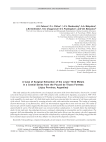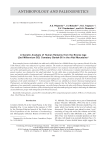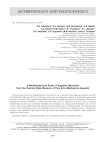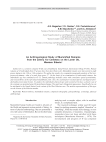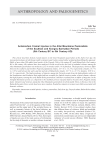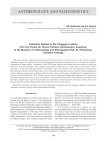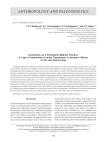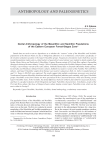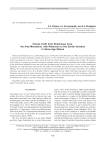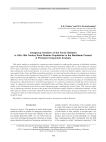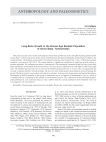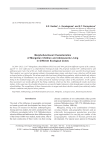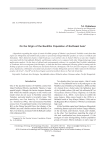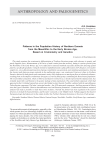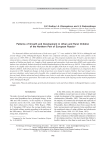Anthropology and paleogenetics. Рубрика в журнале - Archaeology, Ethnology & Anthropology of Eurasia
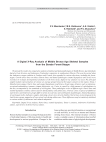
A digital X-ray analysis of Middle Bronze Age skeletal samples from the Baraba forest-steppe
Статья
We present the results of a comparative analysis of skeletal and dental pathologies in Middle Bronze Age individuals buried at Late Krotovo and Andronovo (Fedorovka) cemeteries in southwestern Siberia. This was the period when the Andronovo steppe tradition in Northern and Central Asia expanded in various directions, including the foreststeppe. Growth arrest lines on tibiae (Harris lines) and dental pathologies (enamel hypoplasia and caries) were recorded. To evaluate developmental anomalies in the bone tissue, digital X-ray analysis was used. The principal sample includes representatives of various sex and age groups buried at the largest cemetery in the region, Tartas-1 (Baraba forest-steppe). Harris lines and enamel hypoplasia result from a broad range of factors such as infections, occasional malnutrition, traumas, vitamin defi ciencies, etc. Caries is caused by a high amount of carbohydrates in the diet, accompanied by low standards of oral hygiene. These pathologies occur at different ages: Harris lines and enamel hypoplasia evidence adverse factors during infancy and adolescence, whereas caries is typical of adulthood. Late Krotovo and Andronovo groups differ in terms of occurrence and combination of pathologies. Enamel hypoplasia is less frequent in the Andronovo sample, indicating a lesser stress level in children. Harris lines are less frequent in the Late Krotovo group, suggestive of lower stress level during adolescence. These differences may be tentatively attributed to various models of subsistence and cultural adaptation.
Бесплатно
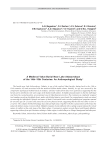
A medieval Yakut burial near lake Atlasovskoye of the 14th–15th centuries: an anthropological study
Статья научная
The burial near Lake Atlasovskoye, Yakutia, is one of the earliest Yakut burials, dating back to the 14th or 15th centuries and associated with the medieval Kulun-Atakh culture. Initially, its age was assessed by the comparative typological method based on artifacts, and later а radiocarbon estimate was generated, suggesting that the burial dates to the early stage of the Kulun-Atakh culture. Its highly unusual feature is that the individual was buried in a seated position – an exceptional case in the Yakut funerary practice. The cranium was completely wrapped in a bandage sewn from birchbark sheets, under which lethal injuries were found. Our comprehensive study was aimed at assessing the individual's lifestyle and cause of death. Postcranial bones revealed pathologal symptoms unusual for an early age (20–25) and caused by excessive physical strain, suggesting that the man was either a slave or a warrior. The complex birchbark bandage may indicate high status. Together with the seated position of the body, this makes the military status even more likely. Multiple traumatic lesions infl icted with a cutting tool indicate the violent nature of confl icts at the early stage of the Yakut culture. Craniometruic analysis reveals Buryat and Mongol affi nities, supporting epic evidence relating to Yakut origins, in which Buryat or Mongol immigrants had taken part.
Бесплатно
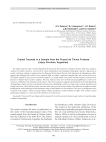
Cranial traumas in a sample from the Pucar'a de Tilcara fortress (Jujuy province, Argentina)
Статья
We analyze injuries in the cranial sample from the Pucará de Tilcara fortress, dating to the time of the Inca conquest. Analysis of violence markers, carried out by visual examination and computed tomography, and the comparison of results with those relating to samples from the Regional Development Period of the Quebrada de Humahuaca valley, suggest that although the violence level remained high, its nature could have changed after the arrival of the Inca. The female sample reveals just two perimortal injuries, no trophy skulls were found, and the frequency of nasal bone fractures is higher than in earlier samples. This may indicate lower level of between-group fi ghting for control over resources, and higher risk of interpersonal violence. The observed pattern suggests that having arrived in the Quebrada de Humahuaca region, the Inca eased political tension by establishing control over trade routes and the distribution of arable land areas, which had previously been the main cause of local armed clashes. The infl uence of artifi cial cranial modifi cations on the pathological and traumatic status of individuals was also analyzed. Two types of modifi cation were recorded in the sample—fronto-occipital tabular oblique and fronto-occipital tabular straight. None of them caused pathological changes or a decrease in the thickness of cranial bones.
Бесплатно
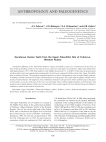
Deciduous human teeth from the Upper Paleolithic site of Yudinovo,Western Russia
Статья обзорная
Бесплатно
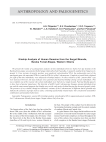
Kinship analysis of human remains from the Sargat mounds, Baraba forest-steppe, Western Siberia
Статья
Бесплатно

